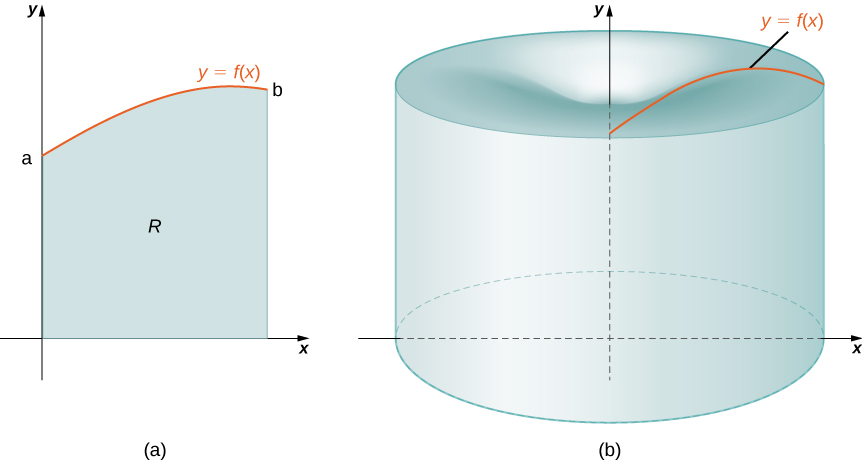
In this section, we examine the method of cylindrical shells, the final method for finding the volume of a solid of revolution. We can use this method on the same kinds of solids as the disk method or the washer method; however, with the disk and washer methods, we integrate along the coordinate axis parallel to the axis of revolution. With the method of cylindrical shells, we integrate along the coordinate axis perpendicular to the axis of revolution. The ability to choose which variable of integration we want to use can be a significant advantage with more complicated functions. Also, the specific geometry of the solid sometimes makes the method of using cylindrical shells more appealing than using the washer method. In the last part of this section, we review all the methods for finding volume that we have studied and lay out some guidelines to help you determine which method to use in a given situation.
Again, we are working with a solid of revolution. As before, we define a region
bounded above by the graph of a function
below by the
and on the left and right by the lines
and
respectively, as shown in [link](a). We then revolve this region around the y-axis, as shown in [link](b). Note that this is different from what we have done before. Previously, regions defined in terms of functions of
were revolved around the
or a line parallel to it.

As we have done many times before, partition the interval
using a regular partition,
and, for
choose a point
Then, construct a rectangle over the interval
of height
and width
A representative rectangle is shown in [link](a). When that rectangle is revolved around the y-axis, instead of a disk or a washer, we get a cylindrical shell, as shown in the following figure.
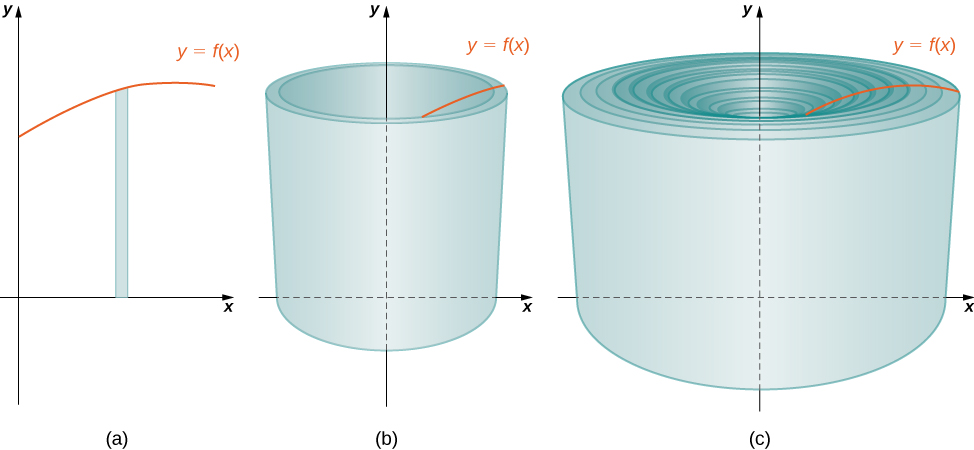
To calculate the volume of this shell, consider [link].
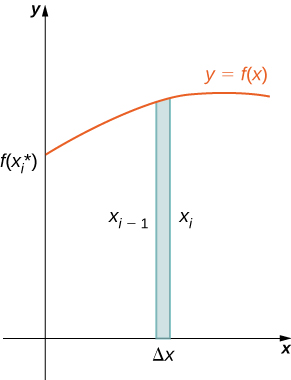
The shell is a cylinder, so its volume is the cross-sectional area multiplied by the height of the cylinder. The cross-sections are annuli (ring-shaped regions—essentially, circles with a hole in the center), with outer radius
and inner radius
Thus, the cross-sectional area is
The height of the cylinder is
Then the volume of the shell is
Note that
so we have
Furthermore,
is both the midpoint of the interval
and the average radius of the shell, and we can approximate this by
We then have
Another way to think of this is to think of making a vertical cut in the shell and then opening it up to form a flat plate ([link]).
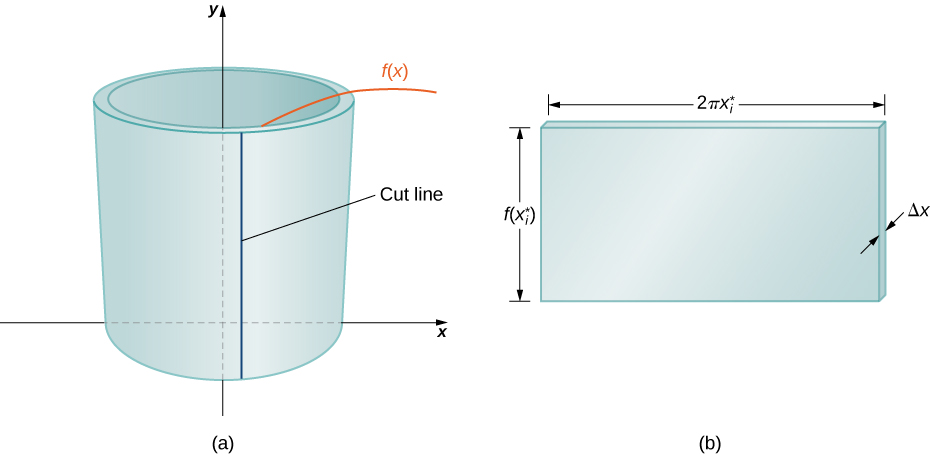
In reality, the outer radius of the shell is greater than the inner radius, and hence the back edge of the plate would be slightly longer than the front edge of the plate. However, we can approximate the flattened shell by a flat plate of height
width
and thickness
([link]). The volume of the shell, then, is approximately the volume of the flat plate. Multiplying the height, width, and depth of the plate, we get
which is the same formula we had before.
To calculate the volume of the entire solid, we then add the volumes of all the shells and obtain
Here we have another Riemann sum, this time for the function
Taking the limit as
gives us
This leads to the following rule for the method of cylindrical shells.
Let
be continuous and nonnegative. Define
as the region bounded above by the graph of
below by the
on the left by the line
and on the right by the line
Then the volume of the solid of revolution formed by revolving
around the y-axis is given by
Now let’s consider an example.
Define
as the region bounded above by the graph of
and below by the
over the interval
Find the volume of the solid of revolution formed by revolving
around the
First we must graph the region
and the associated solid of revolution, as shown in the following figure.
![(a) The region R under the graph of f(x)=1/x over the interval [1,3]. (b) The solid of revolution generated by revolving R about the y-axis. This figure has three images. The first is a solid that has been formed by rotating the curve y=1/x about the y-axis. The solid begins on the x-axis and stops where y=1. The second image is labeled “a” and is the graph of y=1/x in the first quadrant. Under the curve is a shaded region labeled “R”. The region is bounded by the curve, the x-axis, to the left at x=1 and to the right at x=3. The third image is labeled “b” and is half of the solid formed by rotating the shaded region about the y-axis.](../resources/CNX_Calc_Figure_06_03_004.jpg)
Then the volume of the solid is given by
Define R as the region bounded above by the graph of
and below by the x-axis over the interval
Find the volume of the solid of revolution formed by revolving
around the
units3
Use the procedure from [link].
Define R as the region bounded above by the graph of
and below by the
over the interval
Find the volume of the solid of revolution formed by revolving
around the
First graph the region
and the associated solid of revolution, as shown in the following figure.
![(a) The region R under the graph of f(x)=2x−x2 over the interval [0,2]. (b) The volume of revolution obtained by revolving R about the y-axis. This figure has two graphs. The first graph is labeled “a” and is the curve f(x)=2x-x^2. It is an upside down parabola intersecting the x-axis at the origin ant at x=2. Under the curve the region in the first quadrant is shaded and is labeled “R”. The second figure is a graph of the same curve. On the graph is a solid that is formed by rotation the region from “a” about the y-axis.](../resources/CNX_Calc_Figure_06_03_005.jpg)
Then the volume of the solid is given by
Define
as the region bounded above by the graph of
and below by the
over the interval
Find the volume of the solid of revolution formed by revolving
around the
units3
Use the process from [link].
As with the disk method and the washer method, we can use the method of cylindrical shells with solids of revolution, revolved around the
when we want to integrate with respect to
The analogous rule for this type of solid is given here.
Let
be continuous and nonnegative. Define
as the region bounded on the right by the graph of
on the left by the
below by the line
and above by the line
Then, the volume of the solid of revolution formed by revolving
around the
is given by
Define
as the region bounded on the right by the graph of
and on the left by the
for
Find the volume of the solid of revolution formed by revolving
around the x-axis.
First, we need to graph the region
and the associated solid of revolution, as shown in the following figure.
![(a) The region Q to the left of the function g(y) over the interval [0,4]. (b) The solid of revolution generated by revolving Q around the x-axis. This figure has two graphs. The first graph is labeled “a” and is the curve g(y)=2squareroot(y). It is an increasing curve in the first quadrant beginning at the origin. Between the y-axis and the curve, there is a shaded region labeled “Q”. The shaded region is bounded above by the line y=4. The second graph is the same curve in “a” and labeled “b”. It also has a solid region that has been formed by rotating the curve in “a” about the x-axis. The solid starts at the y-axis and stops at x=4.](../resources/CNX_Calc_Figure_06_03_006.jpg)
Label the shaded region
Then the volume of the solid is given by
Define
as the region bounded on the right by the graph of
and on the left by the
for
Find the volume of the solid of revolution formed by revolving
around the
units3
Use the process from [link].
For the next example, we look at a solid of revolution for which the graph of a function is revolved around a line other than one of the two coordinate axes. To set this up, we need to revisit the development of the method of cylindrical shells. Recall that we found the volume of one of the shells to be given by
This was based on a shell with an outer radius of
and an inner radius of
If, however, we rotate the region around a line other than the
we have a different outer and inner radius. Suppose, for example, that we rotate the region around the line
where
is some positive constant. Then, the outer radius of the shell is
and the inner radius of the shell is
Substituting these terms into the expression for volume, we see that when a plane region is rotated around the line
the volume of a shell is given by
As before, we notice that
is the midpoint of the interval
and can be approximated by
Then, the approximate volume of the shell is
The remainder of the development proceeds as before, and we see that
We could also rotate the region around other horizontal or vertical lines, such as a vertical line in the right half plane. In each case, the volume formula must be adjusted accordingly. Specifically, the
in the integral must be replaced with an expression representing the radius of a shell. To see how this works, consider the following example.
Define
as the region bounded above by the graph of
and below by the
over the interval
Find the volume of the solid of revolution formed by revolving
around the line
First, graph the region
and the associated solid of revolution, as shown in the following figure.
![(a) The region R between the graph of f(x) and the x-axis over the interval [1,2]. (b) The solid of revolution generated by revolving R around the line x=−1. This figure has two graphs. The first graph is labeled “a” and is the line f(x)=x, a diagonal line through the origin. There is a shaded region above the x-axis under the line labeled “R”. This region is bounded to the left by the line x=1 and to the right by the line x=2. There is also the vertical line x=-1 on the graph. The second figure has the same graphs as “a” and is labeled “b”. Also on the graph is a solid formed by rotating the region “R” from the first graph about the line x=-1.](../resources/CNX_Calc_Figure_06_03_007.jpg)
Note that the radius of a shell is given by
Then the volume of the solid is given by
Define
as the region bounded above by the graph of
and below by the
over the interval
Find the volume of the solid of revolution formed by revolving
around the line
units3
Use the process from [link].
For our final example in this section, let’s look at the volume of a solid of revolution for which the region of revolution is bounded by the graphs of two functions.
Define
as the region bounded above by the graph of the function
and below by the graph of the function
over the interval
Find the volume of the solid of revolution generated by revolving
around the
First, graph the region
and the associated solid of revolution, as shown in the following figure.
![(a) The region R between the graph of f(x) and the graph of g(x) over the interval [1,4]. (b) The solid of revolution generated by revolving R around the y-axis. This figure has two graphs. The first graph is labeled “a” and has two curves. The curves are the graphs of f(x)=squareroot(x) and g(x)=1/x. In the first quadrant the curves intersect at (1,1). In between the curves in the first quadrant there is a shaded region labeled “R”, bounded to the right by the line x=4. The second graph is labeled “b” and is the same as the graphs in “a”. Also on this graph is a solid that has been formed by rotating the region “R” from the figure “a” about the y-axis.](../resources/CNX_Calc_Figure_06_03_008.jpg)
Note that the axis of revolution is the
so the radius of a shell is given simply by
We don’t need to make any adjustments to the x-term of our integrand. The height of a shell, though, is given by
so in this case we need to adjust the
term of the integrand. Then the volume of the solid is given by
Define
as the region bounded above by the graph of
and below by the graph of
over the interval
Find the volume of the solid of revolution formed by revolving
around the
units3
Use the process from [link].
We have studied several methods for finding the volume of a solid of revolution, but how do we know which method to use? It often comes down to a choice of which integral is easiest to evaluate. [link] describes the different approaches for solids of revolution around the
It’s up to you to develop the analogous table for solids of revolution around the
![This figure is a table comparing the different methods for finding volumes of solids of revolution. The columns in the table are labeled “comparison”, “disk method”, “washer method”, and “shell method”. The rows are labeled “volume formula”, “solid”, “interval to partition”, “rectangles”, “typical region”, and “rectangle”. In the disk method column, the formula is given as the definite integral from a to b of pi times [f(x)]^2. The solid has no cavity in the center, the partition is [a,b], rectangles are vertical, and the typical region is a shaded region above the x-axis and below the curve of f(x). In the washer method column, the formula is given as the definite integral from a to b of pi times [f(x)]^2-[g(x)]^2. The solid has a cavity in the center, the partition is [a,b], rectangles are vertical, and the typical region is a shaded region above the curve of g(x) and below the curve of f(x). In the shell method column, the formula is given as the definite integral from c to d of 2pi times yg(y). The solid is with or without a cavity in the center, the partition is [c,d] rectangles are horizontal, and the typical region is a shaded region above the x-axis and below the curve of g(y).](../resources/CNX_Calc_Figure_06_03_009.jpg)
Let’s take a look at a couple of additional problems and decide on the best approach to take for solving them.
For each of the following problems, select the best method to find the volume of a solid of revolution generated by revolving the given region around the
and set up the integral to find the volume (do not evaluate the integral).
and the
and the
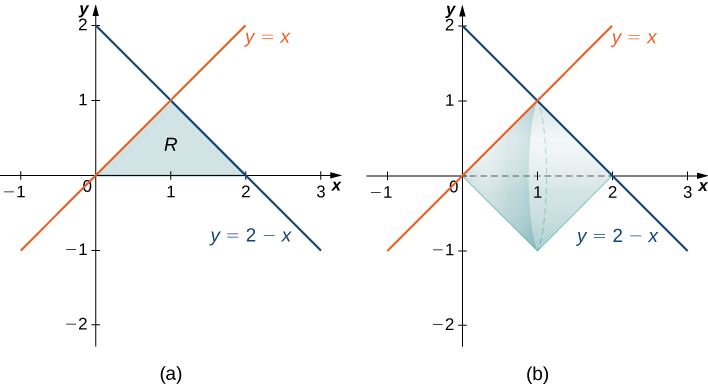
Looking at the region, if we want to integrate with respect to
we would have to break the integral into two pieces, because we have different functions bounding the region over
and
In this case, using the disk method, we would have
If we used the shell method instead, we would use functions of
to represent the curves, producing
Neither of these integrals is particularly onerous, but since the shell method requires only one integral, and the integrand requires less simplification, we should probably go with the shell method in this case.

Looking at the region, it would be problematic to define a horizontal rectangle; the region is bounded on the left and right by the same function. Therefore, we can dismiss the method of shells. The solid has no cavity in the middle, so we can use the method of disks. Then
Select the best method to find the volume of a solid of revolution generated by revolving the given region around the
and set up the integral to find the volume (do not evaluate the integral): the region bounded by the graphs of
and
Use the method of washers;
Sketch the region and use [link] to decide which integral is easiest to evaluate.
For the following exercise, find the volume generated when the region between the two curves is rotated around the given axis. Use both the shell method and the washer method. Use technology to graph the functions and draw a typical slice by hand.
[T] Over the curve of
and
rotated around the
[T] Under the curve of
rotated around the
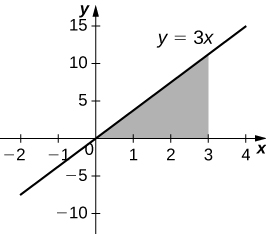
units3
[T] Over the curve of
rotated around the
[T] Under the curve of
rotated around the
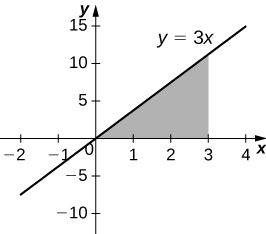
units3
[T] Under the curve of
rotated around the
[T] Under the curve of
rotated around the
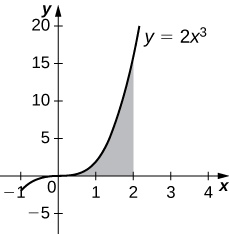
units3
For the following exercises, use shells to find the volumes of the given solids. Note that the rotated regions lie between the curve and the
and are rotated around the
units3
units3
units3
units3
units3
For the following exercises, use shells to find the volume generated by rotating the regions between the given curve and
around the
units3
units3
units3
units3
units3
For the following exercises, find the volume generated when the region between the curves is rotated around the given axis.
rotated around the
rotated around the
units3
rotated around the
rotated around the line
units3
rotated around the line
rotated around the
units3
rotated around the line
rotated around the
units3
rotated around the line
[T] Left of
right of
around the
units3
For the following exercises, use technology to graph the region. Determine which method you think would be easiest to use to calculate the volume generated when the function is rotated around the specified axis. Then, use your chosen method to find the volume.
[T]
and
rotated around the
[T]
rotated around the
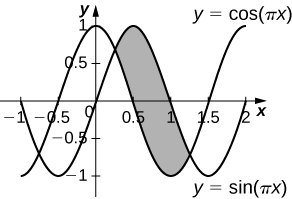
units3
[T]
rotated around the
[T]
rotated around the
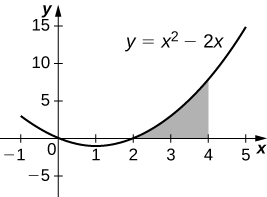
units3
[T]
rotated around the
[T]
rotated around the
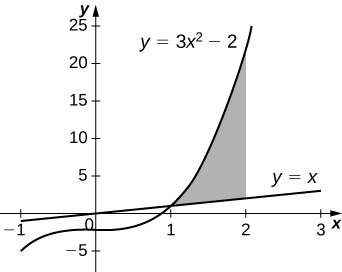
units3
[T]
and
rotated around the
[T]
rotated around the
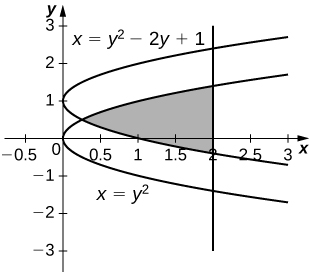
units3
For the following exercises, use the method of shells to approximate the volumes of some common objects, which are pictured in accompanying figures.
Use the method of shells to find the volume of a sphere of radius
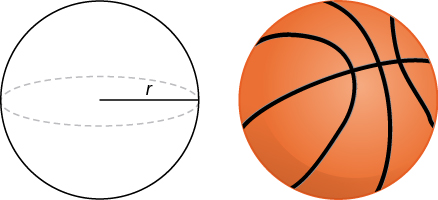
Use the method of shells to find the volume of a cone with radius
and height
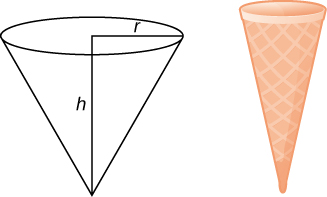
units3
Use the method of shells to find the volume of an ellipse
rotated around the

Use the method of shells to find the volume of a cylinder with radius
and height
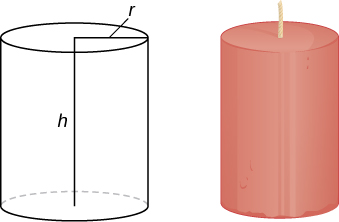
units3
Use the method of shells to find the volume of the donut created when the circle
is rotated around the line
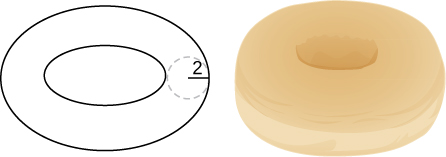
Consider the region enclosed by the graphs of
and
What is the volume of the solid generated when this region is rotated around the
Assume that the function is defined over the interval
units3
Consider the function
which decreases from
to
Set up the integrals for determining the volume, using both the shell method and the disk method, of the solid generated when this region, with
and
is rotated around the
Prove that both methods approximate the same volume. Which method is easier to apply? (Hint: Since
is one-to-one, there exists an inverse

You can also download for free at http://cnx.org/contents/9a1df55a-b167-4736-b5ad-15d996704270@5.1
Attribution: